

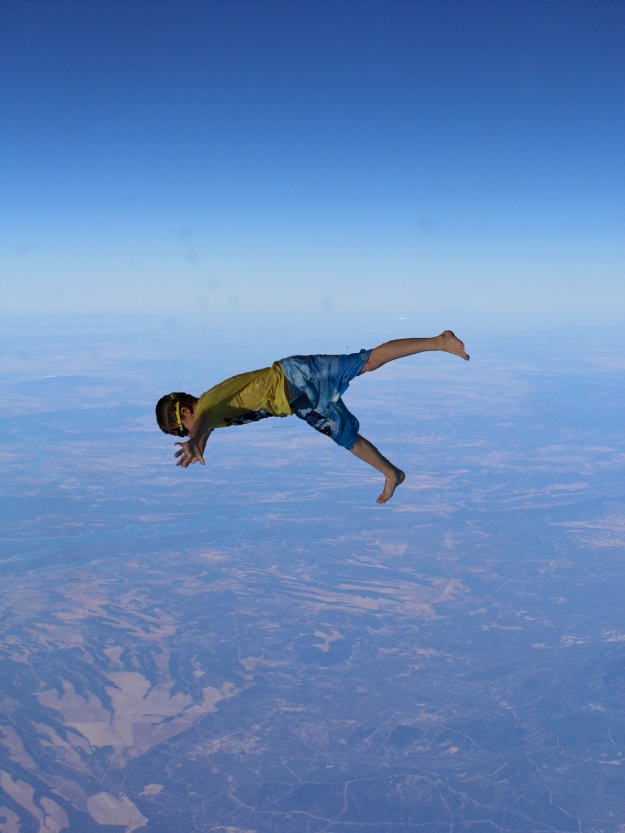 I combined a picture of the sky from an aeroplane with a picture of my grandson jumping into a pool as a first attempt at this exercise. I need to work on keeping edges soft to make a more convincing image.
I combined a picture of the sky from an aeroplane with a picture of my grandson jumping into a pool as a first attempt at this exercise. I need to work on keeping edges soft to make a more convincing image.
Second attempt
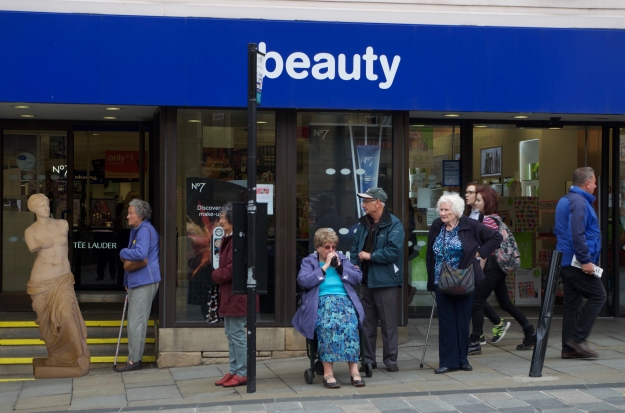



 I combined a picture of the sky from an aeroplane with a picture of my grandson jumping into a pool as a first attempt at this exercise. I need to work on keeping edges soft to make a more convincing image.
I combined a picture of the sky from an aeroplane with a picture of my grandson jumping into a pool as a first attempt at this exercise. I need to work on keeping edges soft to make a more convincing image.


I wonder what Roland Barthe would have made of The Adventures of Guille and Belinda and the Enigmatic Meaning of their Dreams. It seems to me that all Barthe’s comments are self referential and have a very limited application to the extent of not showing an example of his key image, The Winter Garden Photograph. He keeps it to himself because to share it would damage its significance. we are not allowed to see it, only to share his reactions to it. Sanguinetti, on the other hand, invites the viewer into the space between the real and the imagined, what is in front of the camera and how we might react to it: the two blur into one another allowing us to invent a kind of narrative for ourselves that we can understand and even empathise with. The series has the same kind of magical realism as a Gabriel Garcia Marquez story – I’m thinking of Leaf Storm where the man asks for a soup made of the same kind of grass that donkeys eat.

Almeria. Hotel Conde de Floridablanca

Adra, Andalusia. A place to stop and cool off before continuing on to Murcia.
 Murcia. Hotel El Carmen
Murcia. Hotel El Carmen
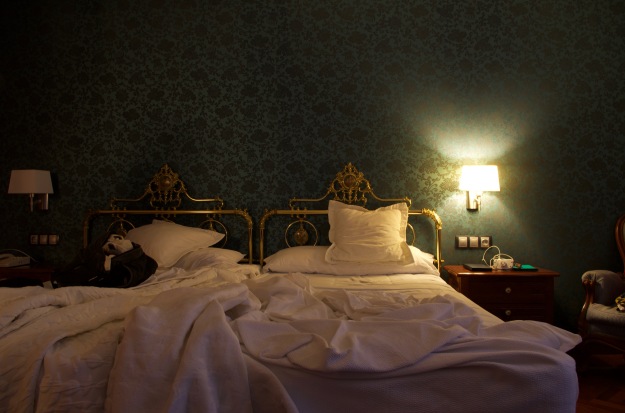
El Burgo de Osma, Hotel Il Virrey.
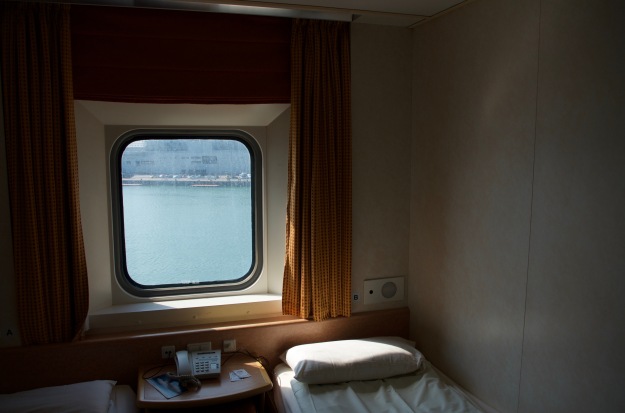
Ferry Cabin

Portsmouth Travelodge
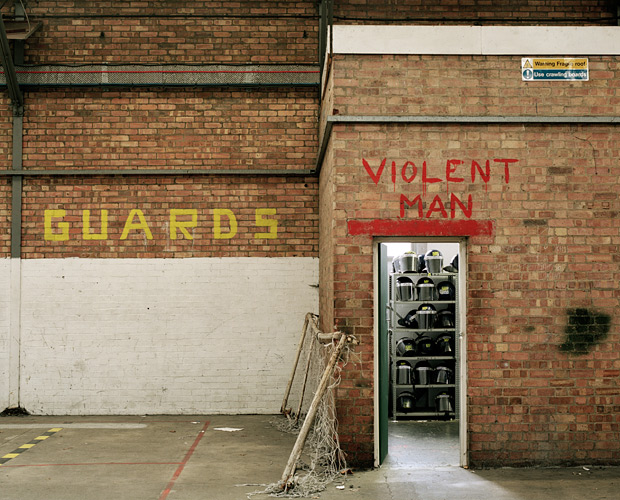
My first impression is of a film set for a dystopian future and then I thought that the set is too clean and artificial. the series is more like a record of a Stalin era training ground for spies than an actual training area of police or fire brigades in Northern Ireland. I wonder how effective the sets were and whether the trainees imagined themselves in episodes of The Prisoner. This is to say that despite the crashed cars, the images of burnt out buildings and so on, we are presented with a shocking reminder that no plan survives first contact with the enemy. We have all seen newsreel of actual riots, damage and destruction and it does not look like this.
On a personal note – I was a student in Paris in 1968-9. I saw riots, chaos and social disorder at first hand. I learned very quickly to run away from the CRS and their pickaxe handles. I see no hint of fear in Sarah Pickering’s images because we can see that the set is a sham. There is no evidence of tear gas, rubber bullets, blood, lost shoes, or water cannon.
If these images are a documentary about how to deal with social disorder their scope is too narrow to be effective. But they do say something about the openness of a society that can allow this kind of look behind the scenes. The context of the set is blurry and so is the narrative. this is not necessarily a bad thing. There is space for the viewer to reflect and make up their own mind about what they are being shown. Does the fact that the authorities gave permission for Sarah Pickering to take these photos and publish them indicate connivance or openness? I this why the scenes seem too clean?
Is this set of images misleading? I don’t think so. After all, there has to be something in front of the camera to make the image. However, the images are very carefully composed. Scenes are selected.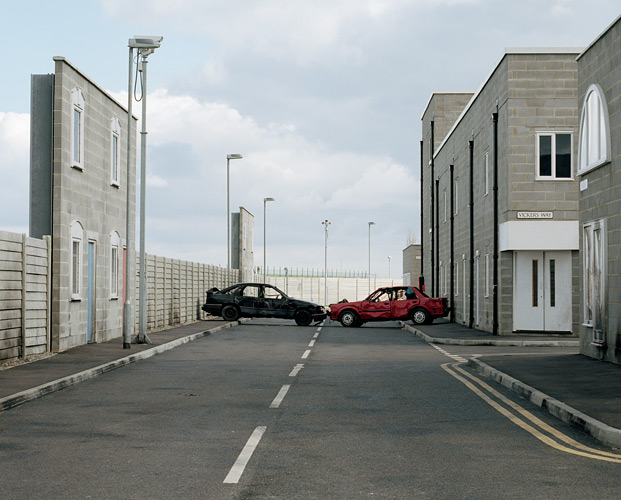
In this example, the two cars are central and at precisely the right distance from the camera to show the falsehood on the left and the presumed reality on the right of the picture. The photographic process contributes to the unreality and absurdity of the images and perhaps that is the point.
Sitting in the Church Square in Llançá I watched this couple taking selfies. First she took a series and then it was his turn. They were laughing and playing and after a while they looked at all the pictures they had taken. Then they went away. I took these photographs.
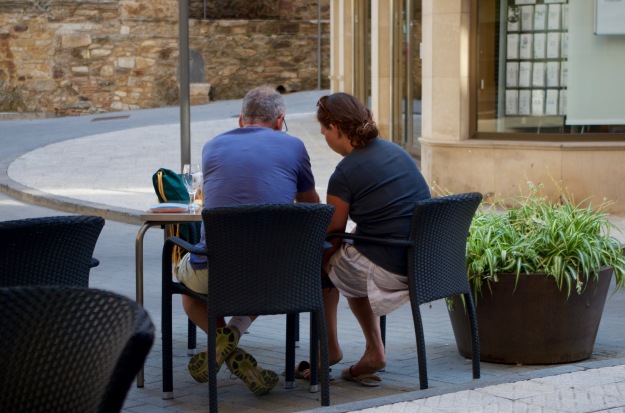

I tried to show the trace they had left on the world but the only clue as to their enjoyment of one another is the two empty glasses and bottles. The chairs wait for the next couple.
The next day I was still thinking about ephemeral things when I saw this at an exhibition in the Château des Adhemars in Montelimar.
“Tadashi Kawamata built a long walkway in wood against the walls around the seigneural apartments. This allowed access to a door, which is normally closed because it is up a height. In this way he transformed the way the building is understood. Stairways, walkways and lean-to huts … all that is left today is the stone. There was much more construction in wood in the Middle Ages.”
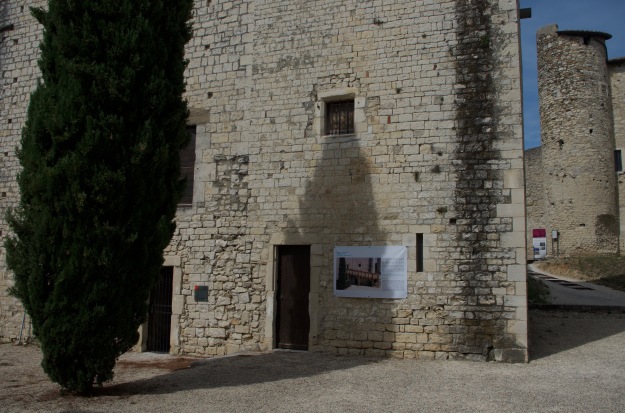
Tadeshi Kawamata’s construction has gone now and again all that is left is the stone. The door up a height is bereft of meaning once again.
My intention in this set of two pairs was to say something about time beyond the simple fraction of a second captured by the photographs. The ‘now’ of the couple and the ‘now’ of Tadeshi Kawamata’s construction have not endured but the contrast between the ‘now and then’ says that something occurred that had duration.
As for the pictures themselves, they are both uncropped. I like the first image, the couple huddled over what I know to be their phone, but the picture doesn’t show that. All the picture shows is a moment of intimacy. I had the camera set at ISO 400 55mm f5.6 1/125. This is a walkaround setting which catches images without too much thought. The settings are the same for the second image. Looking back, this was lazy. The camera resolves detail better at f8 and 1/100 would have been enough to cope with any slight movement. The second image has a distracting shape on the right hand side, which could have been left out and will have to be cropped later.
The second set was taken when the light was much stronger and almost overhead. I set the camera to ISO 160 and f8 or f9.5. The harsh vertical light has made the stone, which my eye tells me is a warm light honey colour, look almost black and white. Should I leave it as it is, or should I Photoshop it to resemble more closely what my eye remembers? In some circumstances this would be a moral choice but it is insignificant here.